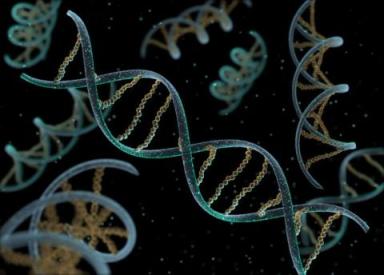Think your DNA is all human? Think again. And a new discovery suggests it’s even less human than scientists previously thought.
 Nineteen new pieces of DNA — left by viruses that first infected our ancestors hundreds of thousands of years ago — have just been found, lurking between our own genes.
Nineteen new pieces of DNA — left by viruses that first infected our ancestors hundreds of thousands of years ago — have just been found, lurking between our own genes.
And one stretch of newfound DNA, found in about 50 of the 2,500 people studied, contains an intact, full genetic recipe for an entire virus, say the scientists who published their findings today in the Proceedings of the National Academy of Sciences.
Whether or not it can replicate, or reproduce, it isn’t yet known. But other studies of ancient virus DNA have shown it can affect the humans who carry it.
In addition to finding these new stretches, the scientists also confirmed 17 other pieces of virus DNA found in human genomes by other scientists in recent years.
The study looked at the entire span of DNA, or genome, from people from around the world, including a large number from Africa — where the ancestors of modern humans originated before migrating around the world. The team used sophisticated techniques to compare key areas of each person’s genome to the «reference» human genome.
Working at Tufts University and the University of Michigan Medical School, the researchers made the findings with funding from the National Institutes of Health.
HERV-enly find
 The findings add to what science already knows about human endogenous retroviruses, or HERVs. That’s the name for the ancient infectious viruses that inserted a
The findings add to what science already knows about human endogenous retroviruses, or HERVs. That’s the name for the ancient infectious viruses that inserted a
Over generations, the
The new HERVs are part of the family called
In the researchers’ own words:
«This one looks like it is capable of making infectious virus, which would be very exciting if true, as it would allow us to study a viral epidemic that took place long ago," says senior author and virologist John Coffin, Ph. D. of the Tufts University School of Medicine. «This research provides important information necessary for understanding how retroviruses and humans have evolved together in relatively recent times.»
«Many studies have tried to link these endogenous viral elements to cancer and other diseases, but a major difficulty has been that we haven’t actually found all of them yet," says

«This is a thrilling discovery," says
Genetic teamwork
The Michigan team used methods for characterizing repetitive DNA sequences that Kidd and his team had developed, while Coffin and Williams used complementary techniques. Wildschutte is now at Bowling Green State University.
Many of the genomes they examined were from the 1000 Genomes Project, an international collaboration. Another set of genomes came from work Kidd and colleagues at Stanford University had done as part of the Human Genome Diversity Project, with a focus on DNA samples from African volunteers.
These latter samples showed more signs of HERVs, in line with the high level of genetic diversity in African populations. That diversity stems from the longtime stability and intermixing of the continent’s population — as opposed to other populations in Europe, Asia and the Americas that stem from specific
Cataloging all the HERV insertions in humans will require even more scanning of whole human genomes, which are becoming easier to come by as technology improves and becomes less expensive. And although intact proviruses lurking in our DNA may be rare, the impact of other HERV sequences on our health or disease is probably not.
The research was funded by the National Institutes of Health (OD009154, CA089441, GM112339) as well as the American Cancer Society and the
Source: http://www.uofmhealth.org/news/archive/201603/more-ancient-viruses-lurk-our-dna-we-thought


